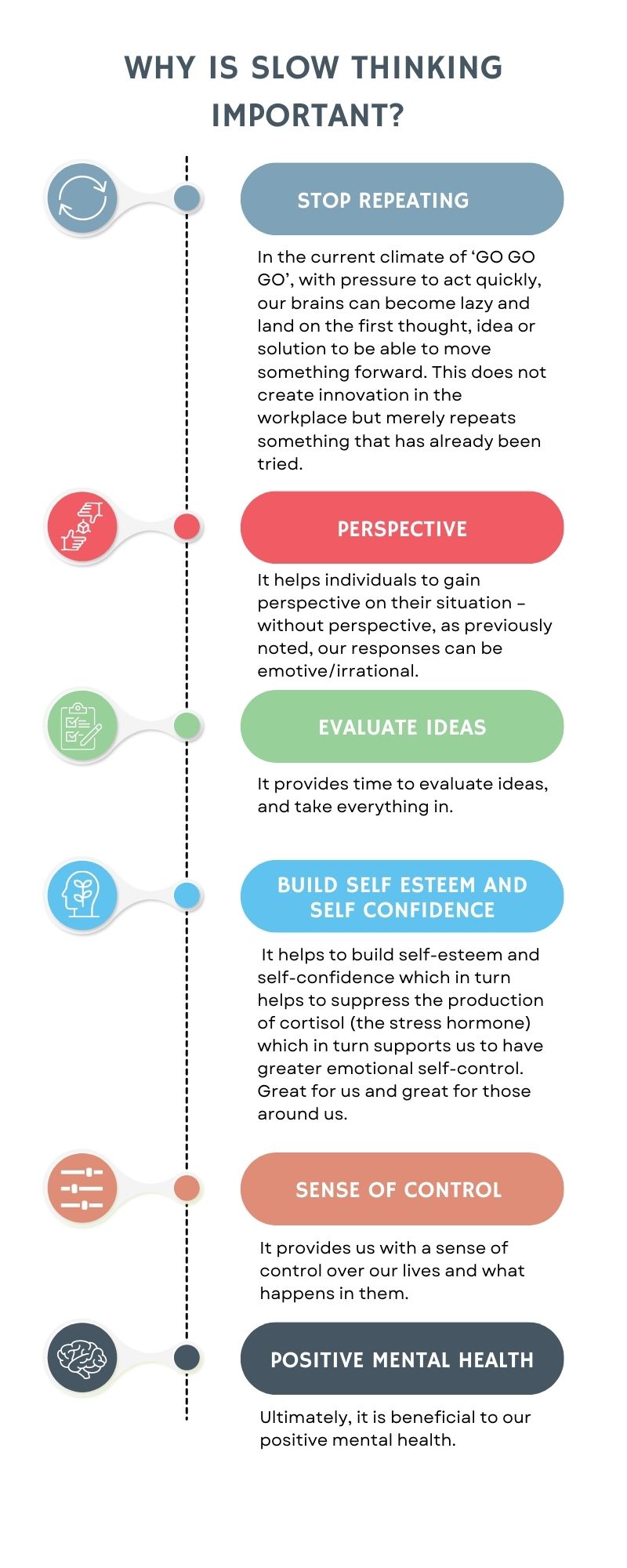

Coaching is an essential leadership skill. In our last blog, I discussed what coaching is (and is not) and why all leaders should learn to coach. The discipline and good practice of the leader to ensure that they are in the best mindset when entering a coaching conversation is essential, but not always easy to achieve when we live in such a fast-paced and demanding world.
It takes discipline and often reflection during or after a high-stress moment to realise that we might need to slow our thinking down a bit, and it is this slow thinking, which can be the key to unlocking further coaching success for both the coach and the coachee.
Why?
Where to start. Our bodies are not designed to cope with the multiple layers of mental load that we carry in modern times. Fundamentally, our brains are programmed to think in quite a basic and catastrophic way; first and foremost, to scan for threats and to do whatever it takes in response to that threat (real or perceived) to keep us alive.
Evolution has not provided us with the natural slow thinking ability; to respond rationally and calmly and we are often in a high state of alert unnecessarily. Physiologically, this means that our brains kick out loads of often unhelpful messages; helpful of course if being chased by a carnivorous predator, not so much if the threat or perceived threat is in the workplace in 2022. This in turn reduces the amount of oxygen in our brains (up to 30% less when under significant stress) as a higher percentage is redirected to our major organs and muscles to prime us to be able to run - literally.
So here we are, in an environment that requires us to think clearly but with brains and bodies that work against us as they were designed to survive through the dark ages and respond physically not necessarily rationally!
In short, in today’s world, during times of stress, we spend sustained periods with less oxygen in our brains than is ideal, this means that our ability to think clearly (and slowly) in times of heightened stress is significantly reduced.
Slow down your thinking.
Well, we can’t change the physiological make-up of our brains, but we can help ourselves and others to think more clearly by slowing down our thinking. This is where coaching can help.
In some of the most basic coaching training, most people will be introduced to a model known as GROW. There are variations on this including ToGROW and iGROW but the basic structure is the same. This model is helpful for several reasons; it keeps discipline in the coaching conversation, especially for those who are newer to coaching and who might be tempted to stray away from the conversation being in the service of the coachee, but it also provides a framework which fundamentally ensures that the experience is challenging enough for insight to be achieved by the Coachee.

So, how does the Coach keep the discipline to slow their thinking in support of others being able to do the same?
Ultimately, this comes down to self-awareness and commitment. A great coach will have bundles of both and be very adept at keeping their own emotions and responses in check to be in the service of someone else.
We’ve all been in those situations where someone shares something emotive, that triggers a response deep within us and we can’t help but share our own experiences in response. The result: We make the conversation about us, not about them.
How does a Coach keep the discipline to support slower thinking?
- Have exceptional self-awareness. Know your triggers, notice them and then metaphorically push them away. Do not bring your thoughts and experiences into the conversation, it is frequently unhelpful and blocks deeper thinking by the Coachee. It’s not about you!
- Be fully present and committed to the person that you are in the conversation with – Don’t get distracted; nothing says ‘you’re not that important and I’m not that interested’ like a glance at your mobile when a new message arrives.
- Trust the Coaching process. Great coaches know that the most focused listening combined with the ability to ask curious and relevant questions will provide the best experience for the Coachee – Follow your own or someone else’s Coaching model such as GROW to keep you on track.
- Be patient – do not interrupt the thinking. This one is a biggy. If we permit the ‘standard’ pace of work and life to dictate the pace of the conversation, the thinking will not deepen. Hold the silence always, this is the gift which supports great, deeper and slower thinking.
- Be interested! Ask questions that you do not know the answers to. Ask more questions than you feel is natural (at first anyway) – Turn the curiosity gauge to maximum and probe into the issue to support increased insight. This can prevent assumptions from being made and again helps to slow the thinking process down.
- Follow the Coachee’s agenda, not yours. ‘Dance in the moment’ (Co-active Coaching) This one is especially tricky for line managers to commit to due to their knowledge of the individual's working set up but it can make all the difference. Spend the time, create an environment where slower thinking is encouraged and support the individual to go where meaning is held for them. You’ll be amazed by what you will both learn.
- Notice what is unsaid and reflect it back as appropriate – What are the non-verbal clues that could support the Coachee’s increased self-awareness of their situation?
- Say less. If there is no real benefit to what you are about to say, don’t say it. Encourage more dialogue with a nod, by holding the silence or by using a different non-verbal encouragement to keep talking. This is often all that is needed.
- Hold enough of the right information to be able to summarise – It is very helpful to hear a summary of your thinking from someone else whose only job is to listen to you. What is staring you in the face can often be completely missed until you hear it back (But please coaches, don’t take physical notes – trust yourself to remember what is important. Taking notes can break the connection and infer that you hold power).
- Confidentiality is critical to creating a high trust and psychologically safe environment – there are very few exceptions to this.
- Commitment. to coaching and to creating a coaching environment so that it becomes part of ‘the way we do things around here’ – building people up in a safe environment, to be the very best versions of themselves where they are recognised, valued for their work and for who they are as their authentic best selves and where others want to be with them.
In this highly complex and fast environment that we live in, providing the space, interest and safety for people to think and speak freely, at their own pace, is hugely empowering and ultimately helps people to unblock whatever is preventing them from being at their best. Surely that investment is worth it every time. Individuals, teams and companies prosper when a coaching environment is created – it’s easy to understand why.
Want to learn more about coaching?
In our next blog on this topic, we will discuss how to embed a coaching culture into your organisation with some practical top tips, so be sure to check back soon!
Similar blogs




